After much success with the Kinetic motion capture/control system (formerly project Natal), Microsoft is thought to be soon releasing the gesture control system for the PC, including laptop and tablet type devices. This could soon start a revolution in computer input. According to this article Microsoft has applied for a US patent called ‘Gesture Keyboarding’ and this article suggests Kinetic for the PC may be imminent, so we have potentially revolutionary times for all RSI sufferers. It will however remain to be seen whether any gesture control system can match the productivity of the keyboard and mouse, but its about time we had a viable alternative!
Category: Ergonomics
The many forms of RSI
 In this blog, I have focused substantially on RSIs associated with computer and mobile device usage, specifically wrist and arm injuries. Of course, there are many other types of injury that can result from occupational overuse, whether you are a programmer, a checkout assistant or a chainsaw operator. Injuries are not confined to work of course, but can also result from leisure pursuits such as piano playing, golf, tennis, running or even Rubik’s cubing! Examples of the types of conditions that can be caused by such activities are: tennis and golfer’s elbow, thoracic outlet syndrome, De Quervain syndrome, as well as the more classic carpal tunnel syndrome and cubital tunnel syndrome.
In this blog, I have focused substantially on RSIs associated with computer and mobile device usage, specifically wrist and arm injuries. Of course, there are many other types of injury that can result from occupational overuse, whether you are a programmer, a checkout assistant or a chainsaw operator. Injuries are not confined to work of course, but can also result from leisure pursuits such as piano playing, golf, tennis, running or even Rubik’s cubing! Examples of the types of conditions that can be caused by such activities are: tennis and golfer’s elbow, thoracic outlet syndrome, De Quervain syndrome, as well as the more classic carpal tunnel syndrome and cubital tunnel syndrome.
Repetitive activities, including computer use, can adversely affect more than just the wrist, hands and arms, but also the neck and shoulders. Some years ago, my wife developed a constant and debilitating shoulder problem on her right side. At the end of each day in the office, her shoulder would ache such that the muscles would feel as if they were exhausted. Being right-handed, the most obvious association was with her computer mouse, yet it was apparent that this type of large-muscle ache would most probably not be addressed by using a different, more ergonomic mouse. It wasn’t until she moved jobs and her new desk included a drop down keyboard and mouse tray that the shoulder injury disappeared. Simply lowering the mouse pad had solved the problem. Even today, should she momentarily use a laptop and external mouse on a table top, for example, the shoulder issue will recur.
In addition, the range of occupations potentially affected by RSIs is wide. On several occasions now, I have encountered checkout cashiers wearing tell-tale arm braces which I instantly recognise as probably indicating an RSI. I have chatted to such individuals and, indeed, they inform me that the repetitive motion of swiping products in front of the barcode scanner has caused their injury. I have recently heard of a tree surgeon having to scale back workload due to pain in his arms from the constant overhead operation of a chainsaw.
Examples of occupations at high risk of RSIs include:
- Journalists, programmers, software engineers – anyone using a computer to do their job
- Construction workers
- Checkout cashiers
- Production assembly line workers
- Machine operators
- Postal sorting workers
Sometimes it is not necessarily repetitive motion that is at fault, but holding the same position for hours on end. For example, many neck problems develop after possibly years of bad posture and/or inadequate breaks whilst staring at a computer screen, or performing any occupation that involves looking downwards (eg a jeweller). Even sleeping is not without hazard, if you are in the habit of lying on your front with your head to one side for example.
Of course, the key words here include “repetitive”, “overuse” and “habit”. The same principles apply in addressing these conditions:
- Awareness
- Good ergonomics
- Adaptive software or hardware (this can include anything from computer mice to chairs to running shoes!)
- Adequate breaks
- Improvement of posture
- Therapeutic exercise such as yoga, pilates etc
- Avoidance, if necessary
So, regardless of whether you are at work or play, upon experiencing the first twinges of pain, it is time to become aware of the cause and to address them accordingly. The choice is yours – you can make the necessary adjustments to your work or leisure habits now, or be forced to give them up entirely later.
Rate this post! [ratings]
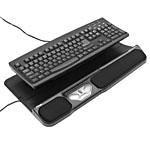 I have released a new page on the site which contains a list of ergonomic products it’s also available from the main menu on this site.
I have released a new page on the site which contains a list of ergonomic products it’s also available from the main menu on this site.
The page is not so much intended as a page of products that I endorse. It is more a collection of the latest products in the field of ergonomic computer input as well as some key older products. It may contain ergonomic products which I find to be useful, potentially useful, or completely bizarre, and will where appropriate have my comments on the product and if available, a link to a review that I have done on the item. I will clearly state whether I have/have not used the product.
The page will be updated/added to as new products appear on the market.
If you are a manufacturer that would like to have their product listed or reviewed by Ergomatters please contact us.
 I am happy to announce the release of my latest update to this site, a Repetitive Strain Injury (RSI) Frequently Ask Questions (FAQ) page along with answers! This is basically a download of information from my head as to my understanding of RSI, along with relevant links and information, and is without doubt the largest information release I’ve done on this site. Hopefully you will find this useful. Please feel free to comment and share.
I am happy to announce the release of my latest update to this site, a Repetitive Strain Injury (RSI) Frequently Ask Questions (FAQ) page along with answers! This is basically a download of information from my head as to my understanding of RSI, along with relevant links and information, and is without doubt the largest information release I’ve done on this site. Hopefully you will find this useful. Please feel free to comment and share.
DVD : Move Well Avoid Injury : What everyone needs to know about the body (by Barbara Conable and Amy Likar, Andover Productions, 2009)
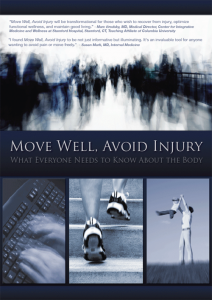 I may not be a medical professional, but I am able to tell when I encounter descriptions of body motion that just make plain sense, and this DVD contains some enlightening information. In a collection of well narrated chapters complete with diagrammatic video illustration, the evidence is laid bare of our common tendencies to keep our bodies out of balance, causing pain through muscle tensions that, in turn, keep our bodies in bad posture. This is due in part to us having mapped the body in a particular way, eg in relation to position, when in reality the position is entirely different.
I may not be a medical professional, but I am able to tell when I encounter descriptions of body motion that just make plain sense, and this DVD contains some enlightening information. In a collection of well narrated chapters complete with diagrammatic video illustration, the evidence is laid bare of our common tendencies to keep our bodies out of balance, causing pain through muscle tensions that, in turn, keep our bodies in bad posture. This is due in part to us having mapped the body in a particular way, eg in relation to position, when in reality the position is entirely different.
This DVD is broken into multiple sections covering the many aspects of posture imbalance, and covers areas from the head to the feet and just about everywhere in between. Posture is translated by the authors as ‘Body Maps’ which are essentially memories in your mind of where you think your individual body parts are and how you use them. The DVD highlights how you may have had a flawed map (understanding) of your various body parts in your mind from a very young age. This may have led you to actually move according to those flaws and results in the straining of some parts of your body which can lead to pain. As the narrator tells us, “We move in the way in which we think we are constructed …”, either consciously or unconsciously. Wrong body maps can be responsible for many bad posture related problems, from walking to sitting, to using a computer.
Subjects covered in the DVD include –
- Body maps – identifying flaws in the human body map and how to recognise those errors
- Balance – identifying correct balance with core posture, and identifying posture related pain
- Kinesthesia – learning free and fluid movement to correct body imbalances
- Arms – covering shoulders, elbows, wrists and hands
- Legs – covering hips, pelvis, knees and feet
- Breathing – covering lungs, skeletal/muscular system, diaphragm
- Mapping the whole body
- Correcting the map
- Inclusive attention
The areas I can relate to most pertain to the shoulders, arms, wrists and hands. These are covered in detail and are very applicable to the RSI sufferer. The main posture/skeletal issues with RSI type injuries are listed, adding to the viewer’s knowledge and understanding through plain and straightforward explanations along with clear diagrams and video.
From previous experience, I knew that over-supination of the wrists was a bad thing, but now I know about the natural axis of rotation of the forearm and how it ties in with a neutral position wrist, as well as why supination causes so many injuries.
The company website rather generously shows sample videos of some chapters which are well worth checking out, and will give you a sneak peak of the DVD content and style as well as some key body map information!
- ‘Elbows’ chapter
- ‘Arms’ chapter
- ‘Forearms’ chapter
- ‘Hands’ chapter
- ‘Lower Back’ chapter
- ‘Balance’ chapter
- ‘Lungs’ chapter
I also found the section on breathing very interesting. It’s probably the first time I’ve been able to picture the role of the diaphragm in breathing, and I certainly had my lungs mapped as being a bit lower than they actually are. The related section on the ribcage was also revealing to me having just recently strained my sternum connective tissue whilst gardening. It also reinforces the benefits of some breathing practices including Yogic breathing (Pranayama).
The DVD run time is a substantial 2hrs, and certainly lends itself to being watched in stages. There is the temptation to skip straight to the section you are most interested in, however it should be watched as a whole to get the complete picture and overall message firmly ingrained in your mind. I expect that multiple viewings would be best to fully absorb the detail.
All in all this DVD is an excellent resource for just about everyone. It is not solely aimed at one specific group of people eg RSI sufferers, but covers the whole body, and should be a useful education tool for everyone, including ergonomists, physiotherapists, fitness instructors, yoga teachers etc, as well as many others including in the medical profession.
If you have posture related pain it’s likely that it’s down to your bad body map and it’s certainly time to re-educate yourself!
Rate this post! [ratings]
In an interesting development, Microsoft has publicly shown at 2009 E3 a next generation games system controller labelled ‘Natal’ that is free of buttons and joysticks; the controller is essentially you. It relies on a sophisticated camera detection system to monitor the user’s motion and translate this motion into games controls. It also has a voice recognition engine. In an article on the BBC news site entitled ‘Microsoft previews new controller‘ a video shows a demonstration.
The reason that developments like this are exciting is that the games business, being a cutting edge, technologically advanced industry, usually pushes the boundaries of software and hardware development for the sake of market share.
Technology like this for, say, computer controls would ordinarily evolve a lot slower if there were a lesser need for it aside from gaming. However, once developed, you can see how it could easily transform into some kind of gesture control for computer operating systems and applications. Who knows, you may even get a workout whilst doing a spreadsheet in the future! Will a workout mat eventually replace the old desk? Maybe we can eliminate the need for going to a gym! Do employers only hire fit people in the future?
We are certainly at a crossroads with computers, where the basic mouse has been around too long and has created too many overuse injuries. It is more than time that we took computer input to a new level of evolution, and this may be the glimpse of what’s to come.
Whether this technology can save us from RSI related injuries is unknown, but it may help wean us off using a mouse. It may also lead to opportunities in computer use for people with all kinds of different disabilities, and not just RSI.
Is this the dawn of a new age in computer ergonomics, or is it just a gimmick ?
Rate this post! [ratings]
Bio Feedback as a tool to combat RSI
Bio Feedback, is a method of measuring an individual’s stresses by monitoring muscle tension, sweat gland behaviour, heart rate etc. It is a non-invasive, non-medical process, designed to raise the awareness of the subject to how their body is reacting to their working environment.
Previously, while living in the US, I was sent for Bio Feedback monitoring, and was ‘hooked up’ to many electrode pads around my neck, shoulders, and arms. These were to be used to measure muscle tension in all the upper body limbs including the neck and shoulder area. The sensors are connected to a computer which plots out the associated muscle tensions on a monitor, so you have real time visualisation of the various muscle tensions you hold in your upper body when operating computer equipment. You are actually seated in front of a real keyboard and mouse, and asked to type and enter data like you normally would in your daily life.
I was actually quite surprised at how much tension the signals showed, and was constantly told to relax the posture to drop the tension levels – not an easy task!
I had to really try to relax my whole body from my head to neck to shoulders to arms to wrist angle to make even the slightest difference. The difficulty was trying to hold it there whilst typing and using a mouse.
Emphasis was placed on relaxing muscles that control the upper limbs, as well as suggestions on how to become more relaxed in the mind both inside and outside of the office environment.
As with other RSI awareness education therapies, there was no magic bullet for me with Bio Feedback, but it certainly helped to raise my awareness of how tense my upper body limbs (including shoulders) became while operating computer equipment, and that really is an important part of the RSI education process.
Rate this post! [ratings]
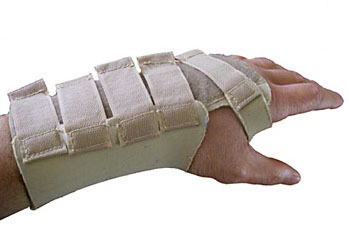 I’ve been through a fair share of wrist braces in my time with RSI. Wrist braces are often the first item you will obtain after seeing a physical therapist about an RSI condition. They can be a lot of help to a RSI sufferer, but have to be used correctly, comfortably, and should not be used if they worsen your RSI symptoms.
I’ve been through a fair share of wrist braces in my time with RSI. Wrist braces are often the first item you will obtain after seeing a physical therapist about an RSI condition. They can be a lot of help to a RSI sufferer, but have to be used correctly, comfortably, and should not be used if they worsen your RSI symptoms.
There are a lot of braces out there, and what works for one person may not work for everyone. Braces are usually made out of neoprene or elasticated material coupled with a metal or hard plastic support to immobilise the wrist.
The primary use of the wrist brace should not be forgotten ie to rest wrist joints and forearm muscles that drive the wrist motion (forearm extensors, flexors), and reduce the pain associated from overuse injuries. While this may sound like a good thing, quite often if you wear a brace while using a computer, you will end up using other muscles in a strenuous way to do the same work, and can cause other injuries because of this.
There is no such thing as an ideal wrist brace, it really depends on what they are trying to do.
In the course of your RSI journey you way well encounter many different styles of wrist braces.
My general rules concerning wrist braces are –
- You shouldn’t jump in and buy a wrist brace without first seeking advice from a physiotherapist or doctor.
- Ideally, it should be used to rest (heal) the wrist and the overused (painful) muscles that drive the wrist extension and flexion, and not worn when using a keyboard or mouse.
- Exceptions to the rule are perhaps specific braces intended to stop excessive flexion of the wrist if you are prone to this. It’s a far better idea to be able to spot this flexion yourself and change it, but if you have difficulty doing this then a brace may be required. Alternatively have someone stand and watch over you with a big stick, you will learn faster then!
- Braces used to rest the wrist should not be too tight, just a snug fit. Over tightening can lead to restricted blood flow to the hand and wrists.
- Consider wearing a wrist brace at night in bed to avoid sleeping with your arms/wrists/hands in bent positions. It is critical that you don’t have a tight brace when doing this so as not to restrict blood flow.
- Don’t use them unless you have to. Its better to know your pain, when it happens and try to make adjustments to your work practice etc to reduce the causes than it is to just ‘bandage up’ your injured wrists into a brace.
- Neoprene braces can be hot, sweaty, smelly and itchy to wear even for short periods of time. Better to look for ventilated elastic material ones.
- Wrist braces are not a good universal fit for everyone, so you may have to make some adjustments to it to make it comfortable, including cutting bits out of it or adding some customised padding.
- Wear them at work and they do flag to your employer and colleagues that you have a RSI problem!
Remember though, wrist braces are not a solution to RSI, they are really only there to rest an injury and ease pain. To address your injury it is far better to try to make adjustments to your work to stop the motion that is causing you to have the pain. In other words, you should monitor your wrist, hand motions at a keyboard etc, and make adjustments to your bad working practices, including posture changes. You should also introduce more regular breaks away from your computer along with a good stretching routine and some physical activity.
Rate this post! [ratings]
There is a revealing quote from Dan Odell (Microsoft‘s in-house ergonomist), in an article titled ‘Elementary Ergonomics’ from ‘T.H.E journal.com’ by Jennifer Grayson . He states that –
“There is a growing awareness of how much of an impact there is on students. A lot of the ergonomists I work with at different companies have been noticing that students are graduating from college and coming into the workforce already with chronic repetitive strain-injury problems. It seems at least from the anecdotal stuff that it’s important to start focusing more on the student population.”
This could unfortunately be the start of the RSI epidemic wave that I have long been expecting. The younger generation coming through universities and colleges of further education are the ones that have been exposed to ‘technology’ since they were born and have grown up accustomed to a hi-tech life full of computers, mobile phones, gaming systems and other ‘daily use’ gadgets in complete ignorance of the danger that they pose. They are the generation that have grown up with an ever expanding level of text messaging.
What this generation does not appreciate are the dangers associated with RSI type conditions and their implications for future employment (and earnings) prospects. I also wonder whether employers realise the risks of employing people with these conditions, especially into computer intensive jobs. It may not be too far in the future before employers start to check for these conditions during a pre hiring medical examination, although it may be hard to diagnose without honesty from the potential employee.
What is obvious to me is that ergonomic and RSI health awareness training currently aimed solely at employed adults has to be brought into schools, colleges and universities also to educate the future employees before they succumb to a debilitating RSI condition when they start their employed adult life.
Rate this post! [ratings]
Breaking the RSI Pain Cycle
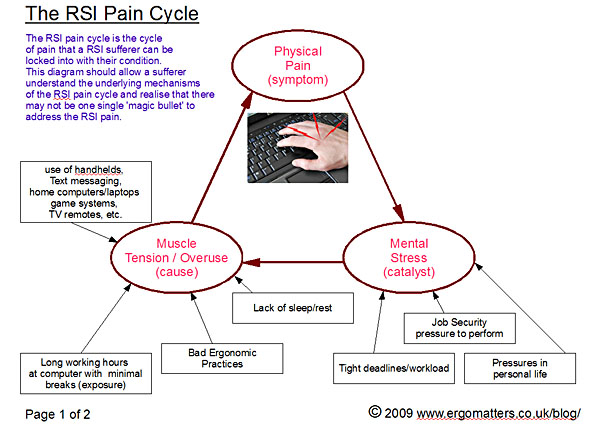 The RSI pain cycle is the cycle of pain that a RSI sufferer can be locked into with their condition. The first diagram on the right (click image to enlarge) should allow a sufferer to understand the underlying mechanisms of the RSI pain cycle and realise that there may not be one single ‘magic bullet’ to address the RSI pain.
The RSI pain cycle is the cycle of pain that a RSI sufferer can be locked into with their condition. The first diagram on the right (click image to enlarge) should allow a sufferer to understand the underlying mechanisms of the RSI pain cycle and realise that there may not be one single ‘magic bullet’ to address the RSI pain.
The RSI pain cycle once ‘locked’ into is a hard one to break free from. The common mistake is to address only one or two factors. If the sufferer is at an early stage of RSI, and is fortunate then one change eg ergonomic setup may be enough to break free, but any medium/long term sufferer who is trapped in this cycle should consider addressing most/all of the underlying trigger causes to allow the transition to an RSI free life. The second diagram (click image to enlarge) shows the key areas to address to break the cycle.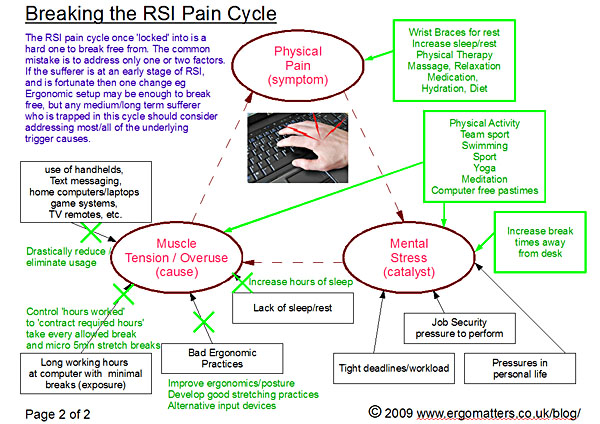
You can also download the 2 diagrams in Breaking The RSI Pain Cycle (pdf)
Rate this post! [ratings]